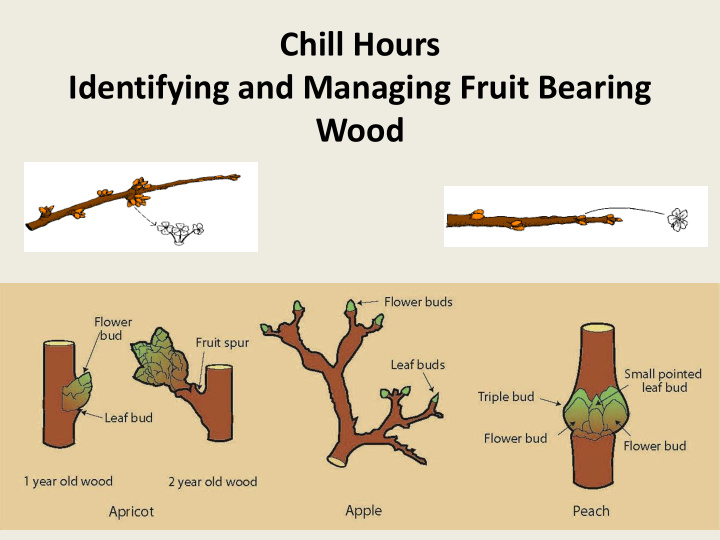



Chill Hours Identifying and Managing Fruit Bearing Wood
Chill Hours • Many fruiting and non-fruiting plants which have evolved in cold climates have developed a method of remaining dormant during freezing weather. This prevents the plants from expending energy and food reserves by developing tender new growth that would be damaged or killed by freezing temperatures. • During the late summer and fall months, these plants produce hormones such as abscisic acid that causes the plant to go into dormancy. • Chill hours are the number of hours of cold that are required to break down or degrade these growth inhibiting hormones so that normal growth can resume. • The chilling requirements (the number of chill hours needed so that the plant can grow normally) can vary tremendously from plant species to plant species and between varieties or cultivars within each species. • Plants that require relatively few, usually 500 or less, chill hours are referred to as low chill varieties.
Chill Hours Chill hours are most commonly defined as follows: 1. The number of hours that occur during the dormant season of the plant which fall between 32 degrees and 45 degrees F. 2. Temperatures below 32 degrees do not qualify as chill hours. 3. If daytime temperature following a night of chill go above 65 or 70 degrees F., the number of hours above that temperature should be subtracted from the accumulated hours of chill received the night before. This definition of chill hours does not always work and there are some theories that are attempting to redefine the definition of chill hours and to develop a better model of how chilling works in plants.
Chill Hours • If a plant does not receive the required number of chill hours to grow properly, the growth or performance of the plant will be impaired. The difference between the number of chill hours required and the number of chill hours received will determine the severity of the effect. • If the difference is relatively minor, normal vegetative growth may occur, however flowering and fruiting will be impaired. • If the difference is greater, vegetative growth will be sluggish and will develop at a less vigorous rate than normal. Flowering and fruiting may be slight or non- existent. • If the difference is relatively large, the tree will remain dormant much later than normal. Growth will be sluggish and flowering will not occur. The tree will enter dormancy earlier in the fall than normal. • If chill hour requirements are not met for several consecutive years, death of the tree will probably occur.
Chill Hours • Having a low chill fruit tree in an area that receives a high number of chill hours may also cause problems. • In this case, the tree may receive the necessary number of chill hours to overcome dormancy very early in the season. If a period of warm weather occurs, the tree may break dormancy and begin growing. Subsequent freezing temperatures will often kill this new growth. • The tree may survive and re-grow when warm weather returns, however flowering will often not occur during the new growth flush. • If this pattern occurs more than once during the winter season, the tree may be killed.
Chill Hours and Microclimates • Accumulated chill hours vary with weather conditions, site exposure, topography, elevation, and geographic location. • Planting deciduous trees in cold air pockets, on north facing slopes or in areas that receive shading during the cold winter months can increase the number of chill hours the trees will receive.
Identifying Fruit-bearing wood • Fruit trees may bear fruit on short-lived (3-5 years) or long- lived (5-10 years or more) fruiting spurs, on last years growth, or on current season growth. • It is extremely important to know the fruiting habits of the fruit tree you are pruning in order to be able to prune correctly and to maximize fruit production. • Each type of fruiting plants bears fruit on wood of a specific age. • Fruit wood should be managed to keep trees productive as well as to prevent over production and to help prevent limbs from breaking.
FRUITING HABITS OF COMMON DECIDUOUS FRUIT AND NUTS Previous-Season's Spurs and Shoots Current-Season's Shoots • Apple — minor • Fig — second crop • Cherry, sour • Persimmon • Pear — minor • Quince • Pomegranate • Walnut Long-lived Spurs • Almond • Apple Previous-Season's Shoots • • Apricot and Aprium — short-lived spur Fig — first crop • Cherry, sour • Filbert • Cherry, sweet • Mulberry • Pear • Nectarine • Pecan • Peach • Plum, • Pistachio • Plumcot • Quince • Pluot • Pomegranate
Current-Season's Shoots Avocado Citrus Fig Surinam Cherry
Previous-Season's Shoots Peach and Nectarine Pomegranate Fig Mulberry Loquat
Fruiting Spurs - Apricot
Fruiting Spurs - Plum
Fruiting Spurs -Apple
Fruiting Spurs - Pear
Fruiting Spurs - Cherry
Managing Fruiting Spurs • As time progresses, fruiting spurs and fruiting wood becomes excessively crowded. This often results in small, poor quality fruit and broken limbs. • Thin out spurs and fruiting branches to improve light penetration and air circulation, reduce overcrowded fruit , reduce the risk of broken branches and to improve the quality of the remaining fruit.
Chill Hours Identifying and Managing Fruit Bearing Wood
Recommend
More recommend